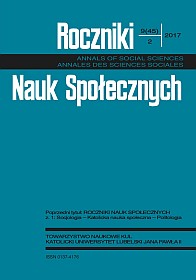The Role of OAUPs in the Prepa-ration of Retirement: Perceptions and Necessities of Older Adults in Spain
Abstrakt
Rola organizacji OAUP w przygotowaniu do przejścia na emeryturę: odczucia i potrzeby osób starszych
Zmiany demograficzne, które dokonują się w Europie, wpływają na przekształcenie typowo piramidalnej struktury populacji, prowadząc do nieodwracalnego procesu starzenia się społeczeństwa. To z kolei stwarza nowe wyzwania, jak i zagrożenia dla kolejnych pokoleń dorosłych, którzy zbliżają się do wieku emerytalnego. Oczekują oni, że będą mogli cieszyć się dłuższym okresem przebywania na emeryturze z powodu poprawy warunków zdrowotnych, a także wzrostu średniej długości życia. Niemniej jednak, mimo że przejście na emeryturę to zasadnicza zmiana w życiu, w większości krajów europejskich nie przeprowadza się do niej żadnych przygotowań. Niniejsza analiza stanowi próbę ukazania, w jaki sposób organizacje OAUP w Hiszpanii mogą być zaangażowane w ten proces i jakie są obszary zainteresowania, na których owe przygotowania winny się koncentrować.
Bibliografia
AEPUM, Evolution in the number of Universities and enrolment figures in Older Adults University Programmes, 2015, Web, Retrieved from http://www.aepumayores.org/en/contenido/statistics-academic-year [Last access: 30/07/2016].
Boulton-Lewisa, G.M., L. Buysa, J. Lovie-Kitchina, Learning and active ageing, „Educational Gerontology”, 32 (4), 2006, p. 271-282.
Bru Ronda C., V.M. Pina Medina, M. Aleson-Carbonell, N. Ruiz Armero, A. López Blanes, V. Sarrión Cano et al, Looking Forward to a Dynamic Third Age – Comparative Survey Report, Alicante: RUA, 2015, Web, Retrieved from http://rua.ua.es/dspace/handle/10045/52175 [Last access: 23/07/2016].
Elínardóttir J., H.K. Gudmundsson, J. Bjornsson, I.R. Gudlaugsdottir, M. Adamczyk, C. Bru Ronda, J.R. Valero Escandell, Looking Forward to a Dynamic Third Age – Comparative Mapping Report, Alicante: RUA, 2015, Web, Retrieved from http://rua.ua.es/dspace/handle/10045/45265 [Last access: 23/07/2016].
Fernández-Ballesteros R., M.A. Molina, R. Schettini, A.L. Rey, Promoting active aging through University Programs for Older Adults, „The Journal of Gerontopsychology and Geriatric Psychiatry”, 25, 2012, p. 145-154.
Fernández-Ballesteros R., M. Caprara, R. Schettini, A. Bustillos, V. Mendoza-Núñez, T. Orsoa, R. Kornfeld et al, Effects of University Programs for Older Adults: Changes in Cultural and Group Stereotype, Self-Perception of Aging and Emotional Balance, „Educational Gerontology”, 39, 2013, p. 119-131.
INE, Basic Demographic Indicators, 2016, Web, Retrieved from http://www.ine.es/dynt3/inebase/index.htm?padre=1365 [Last access: 30/07/2016].
Jiménez Eguizábal A., C. Palmero Cámara, The Quality of University Programs for Older People in Spain: Innovations, Tendencies and Ethics in the face of Active Ageing and the European Higher Education Area, „Education Gerontology”, 34 (4), 2008, p. 325-354.
Phillipson C., J. Ogg, Active Ageing and Universities: Engaging Older Learners. London: Universities UK 2010.
Torre Cruz T. de la, M.I. Luis Rico, M. del C. Escolar Llamazares, J. Huelmo García, Programas universitarios para personas mayores y buenas prácticas, „International Journal of Developmental and Educational Psychology. INFAD Revista de Psicología”, 1(1), 2016, p. 255-264.
Vilaplana Prieto C., Relación entre los Programas Universitarios para Mayores, la satisfacción durante la jubilación y la calidad de vida, „Revista de Investigación Educativa”, 28, 2010, p. 195-216.
Villara F., C. Triadó, S. Pinazo, M. Celdrán, C. Solé, Reasons for Older Adult Participation in University Programs in Spain, „Educational Gerontology”, 36 (3), 2010, p. 224-259.
Copyright (c) 2017 Roczniki Nauk Społecznych

Utwór dostępny jest na licencji Creative Commons Uznanie autorstwa – Użycie niekomercyjne – Bez utworów zależnych 4.0 Międzynarodowe.


